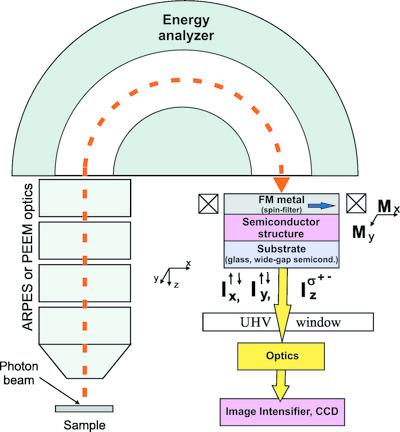当前位置:
X-MOL 学术
›
J. Synchrotron Radiat.
›
论文详情
Our official English website, www.x-mol.net, welcomes your
feedback! (Note: you will need to create a separate account there.)
A new imaging concept in spin polarimetry based on the spin‐filter effect
Journal of Synchrotron Radiation ( IF 2.4 ) Pub Date : 2021-03-30 , DOI: 10.1107/s1600577521002307 Oleg E. Tereshchenko , Vladimir A. Golyashov , Vadim S. Rusetsky , Andrey V. Mironov , Alexander Yu. Demin , Vladimir V. Aksenov
Journal of Synchrotron Radiation ( IF 2.4 ) Pub Date : 2021-03-30 , DOI: 10.1107/s1600577521002307 Oleg E. Tereshchenko , Vladimir A. Golyashov , Vadim S. Rusetsky , Andrey V. Mironov , Alexander Yu. Demin , Vladimir V. Aksenov

|
The concept of an imaging‐type 3D spin detector, based on the combination of spin‐exchange interactions in the ferromagnetic (FM) film and spin selectivity of the electron–photon conversion effect in a semiconductor heterostructure, is proposed and demonstrated on a model system. This novel multichannel concept is based on the idea of direct transfer of a 2D spin‐polarized electron distribution to image cathodoluminescence (CL). The detector is a hybrid structure consisting of a thin magnetic layer deposited on a semiconductor structure allowing measurement of the spatial and polarization‐dependent CL intensity from injected spin‐polarized free electrons. The idea is to use spin‐dependent electron transmission through in‐plane magnetized FM film for in‐plane spin detection by measuring the CL intensity from recombined electrons transmitted in the semiconductor. For the incoming electrons with out‐of‐plane spin polarization, the intensity of circularly polarized CL light can be detected from recombined polarized electrons with holes in the semiconductor. In order to demonstrate the ability of the solid‐state spin detector in the image‐type mode operation, a spin detector prototype was developed, which consists of a compact proximity focused vacuum tube with a spin‐polarized electron source [p‐GaAs(Cs,O)], a negative electron affinity (NEA) photocathode and the target [semiconductor heterostructure with quantum wells also with NEA]. The injection of polarized low‐energy electrons into the target by varying the kinetic energy in the range 0.5–3.0 eV and up to 1.3 keV was studied in image‐type mode. The figure of merit as a function of electron kinetic energy and the target temperature is determined. The spin asymmetry of the CL intensity in a ferromagnetic/semiconductor (FM‐SC) junction provides a compact optical method for measuring spin polarization of free‐electron beams in image‐type mode. The FM‐SC detector has the potential for realizing multichannel 3D vectorial reconstruction of spin polarization in momentum microscope and angle‐resolved photoelectron spectroscopy systems.
中文翻译:

基于自旋滤光片效应的自旋旋光法成像新概念
提出并基于模型系统论证了成像型3D自旋检测器的概念,该概念基于铁磁(FM)膜中的自旋交换相互作用和半导体异质结构中电子-光子转换效应的自旋选择性。 。这个新颖的多通道概念基于将2D自旋极化电子分布直接转移到图像阴极发光(CL)的想法。该探测器是一种混合结构,由沉积在半导体结构上的薄磁性层组成,从而可以从注入的自旋极化自由电子中测量空间和极化相关的CL强度。这个想法是通过测量穿过半导体中传输的复合电子的CL强度,将依赖自旋的电子传输通过面内磁化FM膜进行面内自旋检测。对于具有平面外自旋极化的入射电子,可以从半导体中带有空穴的复合极化电子中检测到圆极化CL光的强度。为了证明固态自旋检测器在图像类型模式下的功能,开发了一种自旋检测器原型,该原型由一个紧凑的邻近聚焦真空管和一个自旋极化电子源组成。p -GaAs(Cs,O)],负电子亲和力(NEA)光电阴极和目标[带有量子阱的半导体异质结构也带有NEA]。在图像类型模式下,研究了通过在0.5–3.0 eV范围内以及高达1.3 keV范围内改变动能,将极化的低能电子注入到目标中。确定作为电子动能和目标温度的函数的品质因数。铁磁/半导体(FM-SC)结中CL强度的自旋不对称性提供了一种紧凑的光学方法,可在图像类型模式下测量自由电子束的自旋极化。FM-SC检测器具有实现动量显微镜和角度分辨光电子能谱系统中自旋极化的多通道3D矢量重建的潜力。
更新日期:2021-05-06
中文翻译:

基于自旋滤光片效应的自旋旋光法成像新概念
提出并基于模型系统论证了成像型3D自旋检测器的概念,该概念基于铁磁(FM)膜中的自旋交换相互作用和半导体异质结构中电子-光子转换效应的自旋选择性。 。这个新颖的多通道概念基于将2D自旋极化电子分布直接转移到图像阴极发光(CL)的想法。该探测器是一种混合结构,由沉积在半导体结构上的薄磁性层组成,从而可以从注入的自旋极化自由电子中测量空间和极化相关的CL强度。这个想法是通过测量穿过半导体中传输的复合电子的CL强度,将依赖自旋的电子传输通过面内磁化FM膜进行面内自旋检测。对于具有平面外自旋极化的入射电子,可以从半导体中带有空穴的复合极化电子中检测到圆极化CL光的强度。为了证明固态自旋检测器在图像类型模式下的功能,开发了一种自旋检测器原型,该原型由一个紧凑的邻近聚焦真空管和一个自旋极化电子源组成。p -GaAs(Cs,O)],负电子亲和力(NEA)光电阴极和目标[带有量子阱的半导体异质结构也带有NEA]。在图像类型模式下,研究了通过在0.5–3.0 eV范围内以及高达1.3 keV范围内改变动能,将极化的低能电子注入到目标中。确定作为电子动能和目标温度的函数的品质因数。铁磁/半导体(FM-SC)结中CL强度的自旋不对称性提供了一种紧凑的光学方法,可在图像类型模式下测量自由电子束的自旋极化。FM-SC检测器具有实现动量显微镜和角度分辨光电子能谱系统中自旋极化的多通道3D矢量重建的潜力。











































 京公网安备 11010802027423号
京公网安备 11010802027423号